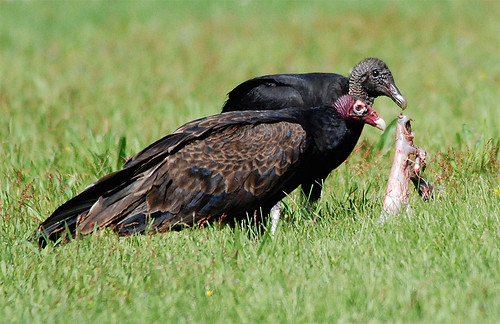
Show me a birder who says vultures are cute, and I’ll show you a liar.
The wrinkled, carcass-like skin on their heads probably won’t ever make me smile like an Indigo Bunting’s bright blue plumage will. Their hunched over walk and black feathers probably won’t either. Watching them soar overhead, while amazing in its own right, isn’t going to compete with a Peregrine Falcon’s dive or a hummingbird’s mid-air hovering act anytime soon (at least not in my book).
Don’t overlook these scavengers, though. They are truly wonders of evolution and are as ecologically fascinating as any other bird you will find. Take their feather-less heads, for example. If a scavenging bird has to stick their face into a nice, fresh deer carcass, what would be the better option? Having a bunch of feathers that are going to collect blood, guts, infectious diseases, and potentially parasites? Or having a head that looks like a feather-plucking machine just got a hold of them, making those big spongy primates say “ew”? I think evolution has ignored us on this one and chosen the latter.

A Black Vulture and Turkey Vulture share a squirrel carcass they have just removed from the road (c) 2009
Vultures also serve important ecological functions. They consume large quantities of dead flesh; dead flesh that would otherwise be crowding our forests, streets, and parks. Sure, there are other scavengers and agents of decay that would eventually do their thing, but few as quickly as the vultures. And some of these other scavengers are animals like rats and feral dogs that carry diseases and act as pests in a variety of other ways.
Unfortunately many species of vulture are in severe decline. “Across the Indian subcontinent, populations of three formerly very common species of vulture have declined by more than 97% as a result of consuming cattle carcasses contaminated with the veterinary drug diclofenac. There have been mass vulture deaths in East Africa associated with misuse of chemicals, huge population declines in West Africa due to habitat loss, and the disappearance of vultures from large areas of their formers ranges in South Africa because of the continued use of vulture parts in traditional medicine and sorcery.” (Source: http://birdlife.org )
Today, September 5th, is International Vulture Awareness Day. Check out the official site at http://www.ivad09.org/ and get some more info about the trouble vultures are in at BirdLife . If you have a blog, please consider participating in the event by posting about vultures. Could be something you write, paint, photograph, draw…anything, really. Get the button and more info here: http://www.ivad09.org/wp/





4 comments:
...wonderful photo...love the detail in their faces and how you caught them with their dinner.
Actually, ... compared to the Marabou Stork the Black Vulture is quite handsome.
Of course, it's the feathers that make the bird. If you take them off any bird you end up with a goosepimpled mini dinosaur.
Great photo, I love how you captured them side by side.
I am not a general birder but I am a hawkwatcher and I love our TVs and BVs. Course what's not to love about a bird that uses projectile vomiting as a means of self-protection and pees on his legs to keep cool.
hello friends I really liked this information, a few days ago I read something similar on a site called wound infections, I would like to receive updates on this issue, as it is very interesting, thanks!
Post a Comment